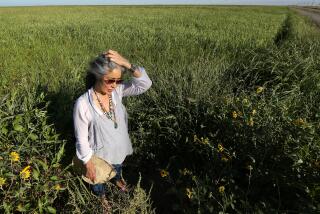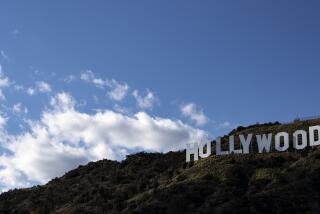Rochester Finds Its Financial Footing Even as Kodak Stumbles
- Share via
ROCHESTER, N.Y. — John Ivey was weeks from becoming a father. John Szebeda was four years short of retirement. Eric Sealy had just moved his family from a trailer park into a brick Colonial in the suburbs.
There had been ominous rumblings and downturns aplenty at Eastman Kodak Co. But when the scythe fell again last winter at the venerable photo giant, it caught many by surprise.
“I kept thinking, ‘I’m young, I’m bright, I’m highly skilled, this wouldn’t necessarily happen to me,’ ” said Ivey, 30, who joined Kodak out of college.
For a century, Rochester had flourished in the shade of a powerful patron. Besides making it possible for countless millions to freeze-frame their world and their memories in snapshots, this was a corporation extolled for taking care of its own.
Even today, as its hometown ranks tumble to 27,700 from a peak of 60,400 in 1982, Kodak’s influence reverberates in Rochester and its Upstate New York surroundings. But that cozy relationship of company and community, perhaps unequaled in the annals of American business, is being tested as never before by the ice-cold realities of Wall Street.
Worldwide, 19,900 layoffs will have cut Kodak’s work force by one-fifth in three years up to the end of 1999. Of these, 6,300 are in Rochester.
The contrasting fortunes of Ivey, Sealy and Szebeda reflect what job counselors believe will play out for an army scrambling to rebuild lives-after-Kodak: Many will fare equally well. Many will get by with less or migrate. And maybe one in five, notably those nearing retirement, won’t get another job or will have “limited opportunity,” reckons Chamber of Commerce President Tom Mooney.
Of 34,000 local employees, 6,300 are being axed through 1999. That’s more livelihoods scuttled more quickly than ever before in the place George Eastman once envisioned as “the best city in which to live and work.”
Kodak’s latest setbacks might have set off devastating ripples had this region of 1 million people not been accustomed to rolling with the punches.
It was a prosperous shoe, clothing and horticulture hub of 90,000 back in 1881 when the young Eastman, engrossed in an arcane art called photography, quit his bank-clerk job to perfect a set of home experiments that rapidly transformed a hobby into a mass commodity.
In place of heavy glass plates, Eastman devised a flexible cellulose film that he sold preloaded in box cameras. He made up the name Kodak because he liked the letter K--”strong and incisive.” Framed in yellow, it became one of the most recognizable brand names on Earth.
In 1900, Eastman came out with a $1 Brownie, turning point-and-shoot photography into an overnight craze. Innovation and mass production were about to put the world into cars and airplanes, the American Century was about to unfold, and Kodak was ready to record it. By 1927, it held a virtual monopoly in the U.S. photographic industry.
Eastman’s munificence was equally legendary. Intent on keeping his employees happy--to this day, they’ve never organized a union--he helped pioneer profit-sharing and, in 1912, began dispensing a generous wage dividend. Going to work for Kodak--”taking the life sentence,” as it was called--became a rite of passage for generations.
The intense concentration of its workers in one medium-sized city added to the esprit de corps. Even off the job, Kodakers gathered at lakeside picnics, the in-house bowling alley and the world’s biggest camera club, with 22 darkrooms and a portrait studio.
It made for a tight-knit, high-minded, secretive, dedicated, slightly stuffy work force--qualities imparted by Eastman that lasted long after he died, unmarried and childless, in 1932.
Eastman had also pumped his riches into hospitals, universities and parks, creating thousands more jobs. His name pops up around every corner here: the Eastman School of Music, the Eastman Dental Center, Durand-Eastman Park.
His most prominent legacy, stretching for miles north of the ornate headquarters tower downtown, is 2,200-acre Kodak Park. By far the biggest industrial plant in the Northeast, it is a curious mix of an old-world chemical plant, complete with smokestacks and aging machinery, and a spotless, sleek engine of the most advanced filmmaking technology anywhere.
Entering the 1980s, Kodak still cornered nearly two-thirds of color-film sales worldwide. But excessive caution in exploiting new markets, such as point-and-shoot 35mm and single-use cameras, was taking its toll.
The innovative Japanese were no longer nibbling at the edges; they were plundering Kodak’s fat profit margins. Tokyo-based Fuji has jumped from obscurity 25 years ago to within a whisker of edging out $16-billion Kodak as No. 1.
As its blue-chip status waned, Kodak was finally forced to cut costs. Mass layoffs came every few years.
Hopes of a turnaround were revived with George Fisher’s arrival from Motorola in 1993. The first outside chief executive in Kodak’s history, he disposed of health-care and chemicals businesses, championed the new era of digital photography, shook up an inbred culture that had stifled creativity and boosted the stock.
Then last year things began unraveling again: Instead of turning its first profit, the digital unit piled up a $440-million loss, while Fuji, setting up shop in South Carolina, slashed U.S. film prices.
Traditional silver-halide film remains Kodak’s cash cow, and Fisher’s response to a price war was to sit tight. The damage only mounted, forcing him to trim $1.5 billion in annual costs.
While discontent with Fisher has swelled, even veteran employees concede that deep cutbacks may be the only option in a rough-and-tumble global marketplace.
But while neighboring cities such as Buffalo and Utica have been battered by the decline of their traditional industries, Rochester is a company town with more than one company to choose from.
Kodak remains the region’s biggest and best-paying employer, but it accounts for just 7% of jobs, down from 14% in 1982. By generating other work--in stores, banks, factories--it sustains roughly one-fifth of the local economy, down from as much as one-third in years past.
Xerox and Bausch & Lomb are also big employers, and in just 15 years, more than 1,500 smaller manufacturers have moved in--many of them people who were hit by downsizings at Kodak and Xerox and went independent.
Exports have soared above $10 billion--the most per capita of any American region. Aggregate income, adjusted for inflation, has held steady since 1980 at around $30,000. And unemployment hovers below the national average, at 4%.
But the city has lost one-third of its population since the 1960s, from 330,000 to 220,000, and is left with deep-seated ailments: high concentrations of poor, 39,000 people on welfare and an unusually high homicide rate--59 last year, compared with 25 in similar-size Jersey City, N.J.
Still, the suburbs are vibrant, new skyscrapers pierce the skyline, a Camden Yards-style stadium draws huge crowds, and giant catamarans may soon be plying Lake Ontario packed with tourists from Canada.
“So long as Kodak shrinks slowly, this community will do just fine,” ventures economist Kent Gardner.
Sealy, 32, signed on in February with a software maker across town that pays just 50 cents an hour less than his technician job at Kodak. But the lack of overtime makes paying the bills a struggle. Paving the muddy driveway and buying new bedroom furniture have been put on hold.
“I know that God’s in control and he’ll open doors for me. I feel life is going good,” said Sealy, whose wife, Holly, stays at home with their two daughters.
Still, it’s hard to leave a company he loved, where his father worked 40 years.
“I wish it was more like the Kodak of old that I heard about,” he said. “People now are so afraid. They don’t open up and share anything because they don’t want to be the next one let go.”
Ivey was thankful to get away.
“As much as I’ll miss Kodak, it’s no way to live, looking over your shoulder every three years,” he said. “I also believe any future growth of the company is going to be in places like China and Mexico and Europe.”
Ivey got an engineering job with a small Rochester sheet-metal company that pays as much as Kodak. But Szebeda, 56, hasn’t been so lucky. A manufacturing engineer who spent 25 years at Kodak, he had expected to retire at age 60 and move to the countryside. Now that dream is fading.
He has scant savings after putting his son through college, but with severance pay and a pension worth 85% of his salary, he reckons he will manage.
“My attitude always has been, whatever happens, put the past behind you, think positive and go dig,” he said, sitting at the kitchen table across from his wife, Arlene. “What I’m finding now is my market is getting much smaller.”
He’s hoping for a college teaching job in the area and recently bought a computer to write a how-to manual for toolmaker apprentices.
“A year down the road, it might be a different story,” he said, his eyes betraying flickers of anguish. Then he cracked a determined smile. “I have this gut feeling,” he said, “it’s going to work out fine.”
More to Read
Inside the business of entertainment
The Wide Shot brings you news, analysis and insights on everything from streaming wars to production — and what it all means for the future.
You may occasionally receive promotional content from the Los Angeles Times.










